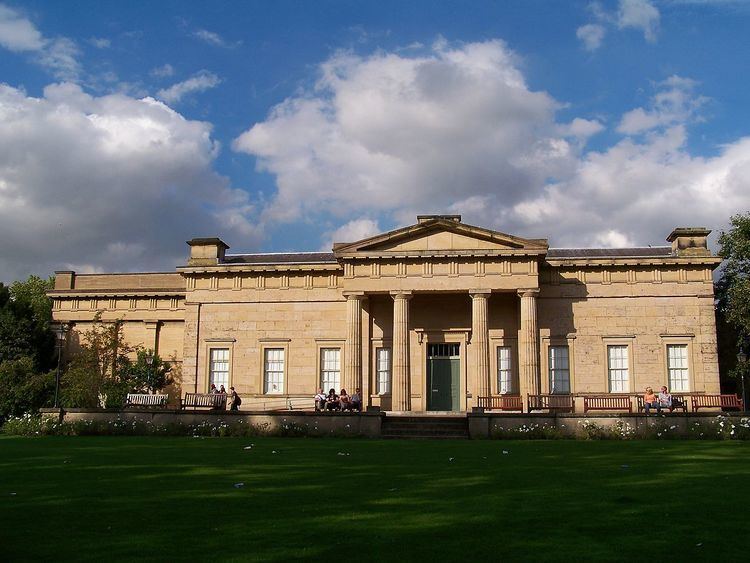Visitors 98,000 (2015) Phone +44 1904 687687 | Opened February 1830 | |
 | ||
Established 1830; 187 years ago (1830) Type Archaeological and Natural Sciences Museum Website www.yorkshiremuseum.org.uk Address Museum Gardens, Museum St, York YO1 7FR, UK Hours Open today · 10AM–5PMSunday10AM–5PMMonday10AM–5PMTuesday10AM–5PMWednesday10AM–5PMThursday10AM–5PMFriday(Good Friday)10AM–5PMHours might differSaturday10AM–5PMSuggest an edit Similar Profiles | ||
The Yorkshire Museum is a museum in York, England. It is the home of the Cawood sword, and has four permanent collections, covering biology, geology, archaeology and astronomy.
Contents
- Learning at the yorkshire museum
- History
- Collections
- Biology
- Geology
- Astronomy
- Archaeology
- Notable collections
- Vale of York Viking hoard
- Events
- References
Learning at the yorkshire museum
History
The museum was founded by the Yorkshire Philosophical Society to accommodate their geological and archaeological collections, and was originally housed in Ousegate, York, until the site became too small. In 1828, the society received by royal grant, 10 acres (0.040 km2) of land formerly belonging to St Mary’s Abbey for the purposes of building a new museum. The main building of the museum is called the Yorkshire Museum; it was designed by William Wilkins in a Greek Revival style and is a Grade I listed building. It was officially opened in February 1830, which makes it one of the longest established museums in England. A condition of the royal grant was that the land surrounding the museum building should be a botanic gardens and one was created in the 1830s. The botanic gardens are now known as the Museum Gardens. On 26 September 1831, the inaugural meeting of the British Association for the Advancement of Science was held at the Yorkshire Museum.
The Tempest Anderson Hall was built in 1912, as an annex to the museum, and is an early example of a reinforced concrete building. It is used as a conference venue and lecture theatre.
In 1960, the museum and gardens were given in trust to York City Council, the successor of which, the City of York Council, set up the York Museums Trust in 2002, to manage the York Castle Museum, York Art Gallery, the Yorkshire Museum and the Museum Gardens.
The museum closed in November 2009 for a major refurbishment and reopened on Yorkshire Day on 1 August 2010. The £2 million scheme was largely carried out by the museum's own staff, who restructured and redecorated the interior of the building. As of January 2016, the museum has the following permanent exhibits: "Roman York – Meet the People of the Empire", "Capital of the North" (Anglian, Viking and Medieval York), and "Extinct: A way of life" a "fun, family-oriented gallery" featuring fossils, skeletons and animal specimens. There are also temporary exhibitions and a historic library and learning space.
Collections
The four permanent collections at the museum all have English designated collection status, which means they are "pre-eminent collections of national and international importance". The collection began in the 1820s, with the collection of animal bones and fossils from Kirkdale Cave.
Biology
The biology collection contains 200,000 specimens, including both fauna and flora, with the majority of the collection made up of insects. There are two stuffed specimens of the extinct great auk, an almost complete skeleton of an extinct moa, and a large collection of specimens from the Yorkshire region including the remains of elephants, cave bears and hyena from Kirkdale Cave dated to the Quaternary period, around 125,000 years.
Geology
The geology collection contains over 112,500 specimens of rocks, minerals and fossils. Fossils make up the majority of the collection numbering over 100,000 samples, and include important specimens from the Carboniferous, Mesozoic and Tertiary periods.
Astronomy
The astronomy collection is mainly kept in the observatory in the museum gardens with some telescopes kept at the Castle Museum in York. The observatory is staffed by volunteers.
Archaeology
The archaeology collection has close to a million objects that date from around 500,000 BC to the 20th century. Most of the objects from the Roman, Anglo Scandinavian and Medieval periods are from the York and Yorkshire area. Following the 2010 refit of the museum, the first gallery displayed parts of the Roman collection, focusing on objects from Eboracum (Roman York). A statue of the Roman God Mars is prominently displayed, and there is an interactive display describing the lives of some of the Romans whose remains have been found in York. The final record of the famous lost Roman legion, the ninth legion, is on display as part of the Roman gallery. The stone inscription, which has been dated to Trajan's twelfth year as emperor, between 10 December 107 and 9 December 108, commemorates the legion's rebuilding in stone of the south-eastern wall of Eboracum's legionary fortress. The BBC reports that "Experts have described it the finest example of Romano British inscription in existence".
The museum houses some collections of forged prehistoric tools by the Yorkshire forger, Flint Jack.
Notable collections
Vale of York Viking hoard
A Viking 10th-century niello silver-gilt pot full of coins was found near Harrogate in 2007. It was valued at £1,082,000, and acquired jointly by the British Museum and the York Museums Trust. After being cleaned by the conservation department of the British Museum, it was displayed at the Yorkshire Museum from 17 September 2009, for a period of six weeks before moving to the British Museum. The hoard was re-displayed at the Yorkshire Museum in 2015.
Events
The museum has 'Finds Days' in the main Yorkshire Museum building where members of the national British Portable Antiquities Scheme and museum staff will identify objects brought to them by members of the public. The information is also recorded to help build up a more complete archaeological picture of the past.
